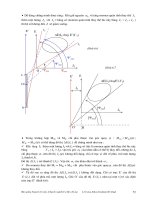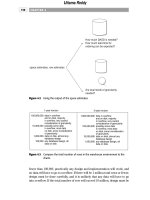The php anthology 2nd edition 2007 - phần 5 pptx
Bạn đang xem bản rút gọn của tài liệu. Xem và tải ngay bản đầy đủ của tài liệu tại đây (3.14 MB, 55 trang )
Chapter
8
Images
Building a web site can extend your creativity far beyond a display of (X)HTML
formatted text, if you so choose. The umbrella term multimedia describes the delivery
of many forms of content to your desktop, including sound, text, images, animation,
and movies. Where images are concerned, PHP has great capabilities—you can use
it to do a whole lot more than simply add static images to your HTML.
Would you like to be able to add a watermark to your images, create appropriately
sized thumbnails for your web page, or build a graph based on figures stored in
your database? Would you like to do all that automatically and on the fly, using
nothing but PHP? We’ll cover all this and more in the following pages.
To use the examples here, you’ll need the GD image library for PHP. I’ll assume you
have GD version 2.0 or higher (bundled with the latest versions of PHP) with Free-
type, JPEG, GIF, and PNG support built in. The PHP functions that use the GD library
are documented in The PHP Manual.
1
The year 2004 saw the end of patent issues
with GIF images, and support for this format in the GD library has been re-enabled
since version 2.0.28, which was released with version 4.3.9 of PHP.
1
Simpo PDF Merge and Split Unregistered Version -
198 The PHP Anthology
Although the GD library supports GIF images again, it’s worth noting that PNG is
capable of supporting alpha channel transparency and full 64-bit images, compared
with GIF’s 8 bits. In addition, PNG uses a more efficient compression algorithm,
reducing the amount of bandwidth required.
While this chapter focuses on the technical details of creating, manipulating, and
using images and related libraries, you might also like to brush up on the basics.
Mike Doughty has a great introduction to working with images and graphics on his
web site.
2
How do I specify the
correct image MIME type?
MIME stands for Multipurpose Internet Mail Extensions, a standard originally
conceived to help identify different email content types. MIME has since become
the de facto standard for the description of content types on the Internet. When you
work with images in PHP, it’s important to have a grasp of the different content
types, or you may end up struggling for hours with what’ s actually a simple problem.
Solution
Generally speaking, your web server must announce content type by way of a special
Content-Type header before it sends requested content to the user’s browser, so
that the browser knows what to do with the content. For example, here are the
headers that a server might send to announce an image in Portable Network
Graphics (PNG) format:
HTTP/1.1 200 OK
Date: Fri, 28 Mar 2003 21:42:44 GMT
Server: Apache/1.3.27 (Unix) PHP/4.3.1
Last-Modified: Wed, 26 Feb 2003 01:27:19 GMT
Content-Length: 1164
Connection: close
Content-Type: image/png
2
Simpo PDF Merge and Split Unregistered Version -
Images 199
The Content-Type header is used to specify the MIME type of the content served
in response to a request for the current URL. In this case, the MIME type is im-
age/png
, which signifies a PNG image.
It’s when we generate an image from a PHP script that the MIME type becomes im-
portant in PHP. By default, PHP scripts send a MIME type of text/html (denoting
an HTML document). So, in instances when your script is sending an image instead
of HTML, you’ll need to specify the MIME type with PHP’ s header function. Here’ s
an example:
<?php
header('Content-Type: image/png');
?>
A list of the common MIME types you’ll need for images is shown in Table 8.1.
Table 8.1. MIME Types for Images
MIME Type Image Format
image/jpeg
a
JPEG File Interchange Format (.jpeg/.jpg)
image/png
Portable Network Graphics (.png)
image/gif
Graphics Interchange Format (.gif)
image/bmp
Windows Bitmap (.bmp)
image/xml+svg
Scalable Vector Graphics (.svg)
a
Internet Explorer understands the image/jpeg type, but when uploading a JPEG image, it sends a
type of
image/pjpeg.
How do I create thumbnail images?
If your site will allow images to be uploaded, perhaps for display with submitted
content, how can you make sure the images displayed will be of a suitable size? If
a user uploads a particularly large image, it might destroy the layout of the page
when it’s displayed.
Solution
One solution to this problem is to create thumbnail images, which guarantee that
the images displayed never exceed certain height and width values.
Simpo PDF Merge and Split Unregistered Version -
200 The PHP Anthology
Building a basic thumbnail is a five-stage process:
1. Load the source image into a PHP variable.
2. Determine the height and width of the original image.
3. Create a blank thumbnail image of the correct size.
4. Copy the original image to the blank thumbnail.
5. Display the thumbnail using the correct content type.
Let’s create a thumbnail from a photo in JPEG format. First, we specify the path to
the source image, as well as our desired width and height in pixels:
thumb.php (excerpt)
<?php
$sourceImage = 'sample_images/terrier.jpg';
$thumbWidth = 200;
$thumbHeight = 200;
Next, we use imagecreatefromjpeg to load an image from the file system into a
PHP variable: $original. The getimagesize function returns the width and height
of the image (we’ll discuss getimagesize further in “How do I resize images without
stretching them?”):
thumb.php (excerpt)
$original = imagecreatefromjpeg($sourceImage);
$dims = getimagesize($sourceImage);
We then use the imagecreatetruecolor function to create a blank image (in memory,
as PHP variable $thumb) into which the thumbnail image will be placed:
thumb.php (excerpt)
$thumb = imagecreatetruecolor($thumbWidth,$thumbHeight);
As the function name suggests, imagecreatetruecolor creates a true color (24-bit)
image, as opposed to the palette-based (8-bit) image that the imagecreate function
provides. The imagecreatefromjpeg function we used previously creates a true
color image from the source file, so we need the thumbnail to be true color as well.
Simpo PDF Merge and Split Unregistered Version -
Images 201
The next line in the example code is the point at which the thumbnail image is ac-
tually created from the original:
thumb.php (excerpt)
imagecopyresampled( $thumb, $original, 0, 0, 0, 0,
$thumbWidth, $thumbHeight, $dims[0], $dims[1] );
The imagecopyresampled function places a resized version of the image into the
blank thumbnail image, resampling along the way to ensure that the image is resized
smoothly. An older version of this function, imagecopyresized, changes the size
of the image more crudely.
The first two arguments to the function represent the destination image, $thumb,
and the source image, $original. The imagecopyresampled function is quite flexible
and can be used to copy a portion of one image into another. The next four arguments
refer to the x and y coordinates of the destination and source image portions, taken
from the top-left corner. As we’re only interested in copying the whole image, we
supply 0 for all four arguments. The final four arguments represent the width and
height of the destination and source image portions. Again, as we wish to copy the
whole image, we supply the full dimensions of each image. Refer to The PHP
Manual for more information.
3
Finally, after we’ve sent the correct content type header, Content-type: image/jpeg,
we use imagejpeg to output the completed thumbnail:
thumb.php (excerpt)
header( "Content-type: image/jpeg" );
imagejpeg( $thumb );
?>
Figure 8.1 shows the end result.
3
Simpo PDF Merge and Split Unregistered Version -
202 The PHP Anthology
Figure 8.1. Our first thumbnail
While there’s certainly room for improvement, this is a start.
How do I resize images
without stretching them?
Unless the original and thumbnail images happen to share the same width-to-height
ratio (or aspect ratio), the process of resizing the images to generate your thumbnails
will warp the dimensions of the images. What we really want is a proportionally
scaled version of the original, which fits into the blank thumbnail as neatly as pos-
sible.
Solution
It’ s possible to determine the original image’ s dimensions and use these to calculate
the proportional dimensions of the thumbnails. The getimagesize function returns
an array of useful information about an image. Here’s an example:
<?php
$sourceImage = 'sample_images/terrier.jpg';
$dims = getimagesize($sourceImage);
echo ( '<pre>' );
print_r($dims);
echo ( '</pre>' );
?>
The above example will display the contents of the $dims variable:
Simpo PDF Merge and Split Unregistered Version -
Images 203
Array
(
[0] => 600
[1] => 450
[2] => 2
[3] => width="600" height="450"
[bits] => 8
[channels] => 3
[mime] => image/jpeg
)
The first element of the array is the width of the image; the second is its height. The
third array element is a number that identifies the type of image, for which a 1 in-
dicates the image is a GIF, 2 indicates a JPEG, and 3 a PNG—more values are de-
scribed in The PHP Manual.
4
The fourth array element contains a string that’s in-
tended to be used within HTML <img> tags. The bits element contains the color
depth.
5
The channels element contains a value of 3 for RGB color images and 4 for
CMYK.
6
The mime element contains the MIME type.
In this section, we’ll write a class called Thumbnail that allows the generation of
proportionally scaled images. The class will also make it possible for us to deal
with images that are smaller than the thumbnail size, allowing them to be left at
their original size if required. The class will be designed to handle PNG and JPEG
files only, but can easily be modified to handle other formats.
We need to define some custom exceptions for our error handling needs before we
start to create our Thumbnail class:
Thumbnail.class.php (excerpt)
class ThumbnailException extends Exception
{
public function __construct($message = null, $code = 0)
{
parent::__construct($message, $code);
4
5
Eight bits can represent 256 colors, and 8-bit color is known as indexed color. True, or 24-bit color can
represent 16,777,216 colors.
6
The RGB (Red-Green-Blue) color model is used for computer displays, while CMYK (Cyan-Magenta-
Yellow-blacK) is used for printing.
Simpo PDF Merge and Split Unregistered Version -
204 The PHP Anthology
error_log('Error in '.$this->getFile().
' Line: '.$this->getLine().
' Error: '.$this->getMessage()
);
}
}
class ThumbnailFileException extends ThumbnailException {}
class ThumbnailNotSupportedException extends ThumbnailException {}
Our base custom exception class, ThumbnailException, ensures the exception details
are logged using the error_log function. The subclasses represent different exception
situations that might arise during the creation of the thumbnail.
As with any class, we start with the class properties:
Thumbnail.class.php (excerpt)
class Thumbnail
{
private $maxWidth;
private $maxHeight;
private $scale;
private $inflate;
private $types;
private $imgLoaders;
private $imgCreators;
private $source;
private $sourceWidth;
private $sourceHeight;
private $sourceMime;
private $thumb;
private $thumbWidth;
private $thumbHeight;
$maxWidth, $maxHeight, $scale, $inflate, $types, $imgLoaders, and $imgCreators
are set by the constructor and are described below. $source, $sourceWidth,
$sourceHeight, and $sourceMime represent the properties of the source image and
will be set by the image loading methods described below. $thumb, $thumbWidth,
and $thumbHeight represent the properties of the created thumbnail and are also
described below.
Simpo PDF Merge and Split Unregistered Version -
Images 205
Next, we create a class constructor:
Thumbnail.class.php (excerpt)
public function __construct($maxWidth, $maxHeight, $scale = true,
$inflate = true)
{
$this->maxWidth = $maxWidth;
$this->maxHeight = $maxHeight;
$this->scale = $scale;
$this->inflate = $inflate;
The constructor for the Thumbnail class takes four arguments. The first two are the
maximum width and height of the thumbnail in pixels, respectively. The third ar-
gument tells the Thumbnail object whether it should scale the image to the thumbnail
proportionally, or just stretch it, as with the earlier example. The fourth argument
tells the Thumbnail object what to do with images that are too small; that is,
whether to blow them up to fill the thumbnail.
With those arguments safely stored in instance variables, we can create the rest of
the constructor:
Thumbnail.class.php (excerpt)
$this->types = array('image/jpeg', 'image/png', 'image/gif');
$this->imgLoaders = array(
'image/jpeg' => 'imagecreatefromjpeg',
'image/png' => 'imagecreatefrompng',
'image/gif' => 'imagecreatefromgif'
);
$this->imgCreators = array(
'image/jpeg' => 'imagejpeg',
'image/png' => 'imagepng',
'image/gif' => 'imagegif'
);
}
The $this->types property stores an array of the MIME types that this class can
handle. The $this->imgLoaders property stores the names of the functions used
to load images of those MIME types, while the $this->imgCreators property stores
the names of the functions for creating new images of those types.
Simpo PDF Merge and Split Unregistered Version -
206 The PHP Anthology
The Thumbnail class provides two methods for loading the image you want to con-
vert. The first, loadFile, allows you to specify a local file to load:
Thumbnail.class.php (excerpt)
public function loadFile ($image)
{
if (!$dims = @getimagesize($image))
{
throw new ThumbnailFileException(
'Could not find image: '.$image);
}
if (in_array($dims['mime'],$this->types))
{
$loader = $this->imgLoaders[$dims['mime']];
$this->source = $loader($image);
$this->sourceWidth = $dims[0];
$this->sourceHeight = $dims[1];
$this->sourceMime = $dims['mime'];
$this->initThumb();
return true;
}
else
{
throw new ThumbnailNotSupportedException(
'Image MIME type '.$dims['mime'].' not supported');
}
}
The loadFile method uses the getimagesize function to grab all the required image
properties, including width, height, and MIME type. If getimagesize returns false,
an error has occurred and we throw one of our custom exceptions,
ThumbnailFileException. If the MIME type of the image is not on our list of sup-
ported types, we throw a ThumbnailNotSupportedException. If all’s well, we load
the image via the image loading function that’s appropriate for the MIME type, and
assign it to the $this->source property. We also assign the image width to the
$this->sourceWidth property, the image height to the $this->sourceHeight
property, and MIME type to the $this->sourceMime property.
After all the instance variables are set, the method calls the initThumb method,
which we’ll tackle in a moment. Finally, having no exceptions, the method returns
true.
Simpo PDF Merge and Split Unregistered Version -
Images 207
The loadData method performs the same function as loadFile, except that we load
an image from a string rather than a file. The string might come from a database, for
example. Here’s our loadData method:
Thumbnail.class.php (excerpt)
public function loadData ($image, $mime)
{
if ( in_array($mime,$this->types) ) {
if($this->source = @imagecreatefromstring($image))
{
$this->sourceWidth = imagesx($this->source);
$this->sourceHeight = imagesy($this->source);
$this->sourceMime = $mime;
$this->initThumb();
return true;
}
else
{
throw new ThumbnailFileException(
'Could not load image from string');
}
}
else
{
throw new ThumbnailNotSupportedException(
'Image MIME type '.$mime.' not supported');
}
}
While the loadData method performs the same function and sets the same instance
variables as the loadFile method, the functions it uses are not the same as
loadFile’s. The loadData method first uses the imagecreatefromstring function
to load the image, throwing a ThumbnailFileException if the image cannot be cre-
ated. The imagecreatefromstring will return an image resource obtained from the
string data passed to the function in the argument. The width and height of our
source images are obtained by the imagesx and imagesy functions, which, predict-
ably, return an image’s width and height. In addition to the image data, you also
need to supply the MIME type as the second argument to the loadData method.
Next, the buildThumb method is used to render the finished thumbnail:
Simpo PDF Merge and Split Unregistered Version -
208 The PHP Anthology
Thumbnail.class.php (excerpt)
public function buildThumb($file = null)
{
$creator = $this->imgCreators[$this->sourceMime];
if (isset($file)) {
return $creator($this->thumb, $file);
} else {
return $creator($this->thumb);
}
}
If you pass this method a filename, the thumbnail will be stored as a file that uses
the name you’ve specified. Otherwise, the image is output directly to the browser,
so you’ll need to make sure that you’ve sent the correct HTTP header first, which
you’ll see in the usage example that follows the Thumbnail class description. Notice
that we use the image function names we assigned to the $this->imgCreators
property in the constructor.
The final public methods are used to glean information about the thumbnail. The
getMime method returns the MIME type, which can be used to generate a Content-
Type
header for the thumbnail:
Thumbnail.class.php (excerpt)
public function getMime()
{
return $this->sourceMime;
}
The getThumbWidth and getThumbHeight methods are used to return the width and
height of the thumbnail in pixels; you could use that information to create an HTML
img tag, for example:
Thumbnail.class.php (excerpt)
public function getThumbWidth()
{
return $this->thumbWidth;
}
public function getThumbHeight()
Simpo PDF Merge and Split Unregistered Version -
Images 209
{
return $this->thumbHeight;
}
Our class has a private method, called initThumb, that’s called by the loading
methods I described previously. initThumb handles the scaling and inflating func-
tions of our class. The first step is to handle scaling:
Thumbnail.class.php (excerpt)
private function initThumb ()
{
if ( $this->scale )
{
if ( $this->sourceWidth > $this->sourceHeight )
{
$this->thumbWidth = $this->maxWidth;
$this->thumbHeight = floor(
$this->sourceHeight *
($this->maxWidth/$this->sourceWidth)
);
}
else if ( $this->sourceWidth < $this->sourceHeight )
{
$this->thumbHeight = $this->maxHeight;
$this->thumbWidth = floor(
$this->sourceWidth *
($this->maxHeight/$this->sourceHeight)
);
}
else
{
$this->thumbWidth = $this->maxWidth;
$this->thumbHeight = $this->maxHeight;
}
}
This part of the function will check to ascertain whether or not image scaling is re-
quired. If it is, some calculations will be performed to determine the appropriate
size for the thumbnail so that it matches the width and height ratio of the original
Simpo PDF Merge and Split Unregistered Version -
210 The PHP Anthology
image, constraining the longest axis to the maximum size originally supplied to the
constructor.
If scaling isn’t required, we simply use the $maxWidth and $maxHeight values ori-
ginally supplied to the constructor:
Thumbnail.class.php (excerpt)
else
{
$this->thumbWidth = $this->maxWidth;
$this->thumbHeight = $this->maxHeight;
}
The next step is to create our blank thumbnail image by employing the
imagecreatetruecolor function:
Thumbnail.class.php (excerpt)
$this->thumb = imagecreatetruecolor(
$this->thumbWidth,
$this->thumbHeight
);
The final step in our initThumb method is to copy the source image into our
thumbnail image:
Thumbnail.class.php (excerpt)
if ( $this->sourceWidth <= $this->maxWidth &&
$this->sourceHeight <= $this->maxHeight &&
$this->inflate == false )
{
$this->thumb = $this->source;
}
else
{
imagecopyresampled( $this->thumb, $this->source, 0, 0, 0, 0,
$this->thumbWidth, $this->thumbHeight,
$this->sourceWidth, $this->sourceHeight
);
Simpo PDF Merge and Split Unregistered Version -
Images 211
}
}
}
If the source image is smaller than the specified thumbnail image size and the
inflate property is set to false, the thumb property is set to the original image.
Otherwise, the imagecopyresampled function is used to resample the source image
into the blank thumbnail image. We talked about the imagecopyresampled function
in more detail in “How do I create thumbnail images?”.
That’s it for our class! Let’s take it for a spin. Here’s a quick demonstration that
outputs a thumbnail based on a file:
thumbFromFile.php (excerpt)
<?php
require_once('Thumbnail.class.php');
$tn = new Thumbnail(200,200);
$tn->loadFile('sample_images/terrier.jpg');
header('Content-Type: '.$tn->getMime());
$tn->buildThumb();
?>
First, we instantiate a Thumbnail object, specifying that we want our thumbnail to
have dimensions of 200×200px. Then we call the loadFile method and pass it a
filename. We use the PHP header function together with the getMime method to
send the correct HTTP header; then, we simply call the buildThumb method to dis-
play the image. The result of our work is shown in Figure 8.2.
Figure 8.2. A proportionally scaled thumbnail
Here’s another example to show off the loadData method and illustrate how files
can be stored rather than output directly:
Simpo PDF Merge and Split Unregistered Version -
212 The PHP Anthology
beforeAndAfter.php (excerpt)
<?php
require_once('Thumbnail.class.php');
$tn = new Thumbnail(200, 200);
$image = file_get_contents('sample_images/terrier.jpg');
$tn->loadData($image, 'image/jpeg');
$tn->buildThumb('sample_images/nice_doggie.jpg');
?>
We begin by including our class and instantiating our Thumbnail object. We simulate
a source image string with the file_get_contents function. In a real-world situation,
of course, this string would probably come from a database. We use the loadData
method to load our image string and call the buildThumb method, but this time we
also pass a filename argument to make the method save our thumbnail to a file at
sample_images/nice_doggie.jpg.
Next comes the HTML for our example page:
beforeAndAfter.php (excerpt)
<!DOCTYPE html public "-//W3C//DTD XHTML 1.0 Transitional//EN"
"
<html xmlns=" /> <head>
<title> Thumbnail Example </title>
<meta http-equiv="Content-Type"
content="text/html; charset=iso-8859-1" />
<style type="text/css">
div { float: left; }
</style>
</head>
<body>
<div>
<h1>Before </h1>
<p>
<img src="sample_images/terrier.jpg" alt="Original Image" />
</p>
</div>
<div>
<h1>After </h1>
<p>
<img src="sample_images/nice_doggie.jpg"
Simpo PDF Merge and Split Unregistered Version -
Images 213
width="<?php echo ( $tn->getThumbWidth() );?>"
height="<?php echo ( $tn->getThumbHeight() );?>"
alt="Resized Image" />
</p>
</div>
</body>
</html>
Notice that as we generate the image tag for the thumbnail, we use the getThumbWidth
and getThumbHeight methods to complete the <img> tag’ s width and height attrib-
utes. The resulting page can be seen in Figure 8.3.
Figure 8.3. The image before and after resizing
There, now Rover looks cute at any size!
Simpo PDF Merge and Split Unregistered Version -
214 The PHP Anthology
How can I put together a
simple thumbnail gallery?
In the previous section, we investigated how to how to create thumbnails without
causing your much-loved pooch to look like some strange dog–bat hybrid. Armed
with that knowledge, it should be an easy task to build a simple thumbnail gallery
from a directory that contains PNG, GIF, and JPEG files!
Solution
We’ll use the Thumbnail class we created in the previous section, together with
PHP’s built-in dir pseudo-class (refer to the section called “Using the dir Pseudo-
Class” in Chapter 6 for more information on the dir pseudo-class) to create our
gallery. We simply read through the directory, look for images that don’t have
thumbnails, and create them; at the same time, we generate the HTML that will
display them. An important benefit of this approach—creating and storing thumb-
nails on the disk—is that it saves us the overhead of having to create the thumbnails
dynamically each time.
The first step we need to take, of course, is to include our Thumbnail class and ini-
tialize our $image_html variable to an empty string:
thumbGallery.php (excerpt)
<?php
require_once('Thumbnail.class.php');
$image_html = '';
The $image_html variable will eventually hold all the HTML for our gallery.
Next, we use the dir pseudo-class to get a Directory object for our sample_images
directory. This object allows us to start a while loop, which will loop over all the
directory entries within sample_images:
thumbGallery.php (excerpt)
$dir = dir('sample_images');
while ($image = $dir->read())
{
Simpo PDF Merge and Split Unregistered Version -
Images 215
Each loop will assign the next directory entry, obtained using the $dir->read
method, to the $image variable. When there are no more directory entries, the loop
will terminate.
Next, we check that the directory entry we’ve obtained is an image file we want to
include in our gallery:
thumbGallery.php (excerpt)
$ext = explode('.',$image);
$size = count($ext);
if (($ext[$size-1] == 'png' ||
$ext[$size-1] == 'jpg' ||
$ext[$size-1] == 'gif')
&& !preg_match('/^thumb_/', $image)
&& $image != '.' && $image != ' ')
{
To check that the current directory entry is an image we want to include in our
gallery, we first examine the file extension to ensure it’s a .png, .jpg, or .gif. We then
make sure that the filename doesn’t begin with thumb_, which would indicate that
it’s one of our thumbnails, and that the entry is not the . or directory entry.
Provided these conditions are met, we proceed to create the thumbnail:
thumbGallery.php (excerpt)
if ( !file_exists('sample_images/thumb_'.$image) )
{
$tn = new Thumbnail(200, 200, true, false);
$tn->loadFile('sample_images/'.$image);
$tn->buildThumb('sample_images/thumb_'.$image);
}
First, we check to make sure a thumbnail doesn’t already exist for the current image.
Then, we create a new thumbnail with our Thumbnail class and save it, prepending
thumb_ to the filename.
The last step inside the while loop adds the HTML markup for the current image:
Simpo PDF Merge and Split Unregistered Version -
216 The PHP Anthology
thumbGallery.php (excerpt)
$image_html .= '<div class="image">' .
'<a href="sample_images/'.$image.'">' .
'<img src="sample_images/thumb_'.$image.'">' .
'</a></div>';
}
}
?>
The HTML for the gallery page is quite simple; once the layout and the CSS style
sheet have been created, the markup for the images is output from the $image_html
variable:
thumbGallery.php (excerpt)
<!DOCTYPE html public "-//W3C//DTD XHTML 1.0 Transitional//EN"
"
<html xmlns=" /> <head>
<title> Thumbnail Example </title>
<style type="text/css">
⋮ insert attractive visual style here…
</style>
</head>
<body>
<h1>Gallery</h1>
<?php echo ( $image_html ); ?>
</body>
</html>
An example of this script’s output appears in Figure 8.4.
Simpo PDF Merge and Split Unregistered Version -
Images 217
Figure 8.4. Our thumbnail gallery
How do I extract EXIF
information from images?
Now that you have a functional gallery, you might like to provide visitors with extra
information about the photo. The exchangeable image file format, better known as
EXIF format, provides a mechanism for the storage of metadata within images; most
digital cameras and image editing applications support this facility natively. If
you’ve taken some of the images in your photo gallery with your digital camera,
you can extract the EXIF data, such as date and time of the photo, the camera
model, and the camera settings used, and display it alongside the shots.
Solution
Extracting this information is simplicity itself when you seek a little help from
PHP’s EXIF functions. To use the EXIF functions you need to ensure your PHP in-
Simpo PDF Merge and Split Unregistered Version -
218 The PHP Anthology
stallation has EXIF support enabled. Please read the instructions on the EXIF
functions manual page.
7
The exif_read_data function reads all the meta information from a JPEG or TIFF
image into an array. Take a look at this example:
exif.php (excerpt)
<?php
// Get the exif data
$exif_data = exif_read_data( 'sample_images/terrier.jpg' );
echo '<pre>';
print_r($exif_data);
echo '</pre>';
?>
The above code displays all the EXIF information available for an image. For the
sake of brevity, as there’s a lot of meta information in the array, here’s a subset of
the information available to us:
Array
(
[FileName] => terrier.jpg
[FileDateTime] => 1185158396
[FileSize] => 46196
[FileType] => 2
[MimeType] => image/jpeg
[Make] => FUJIFILM
[Model] => FinePix S9500
[ExposureTime] => 10/520
[FNumber] => 390/100
[ISOSpeedRatings] => 80
[ShutterSpeedValue] => 576/100
)
Let’s take this information and update the output for the gallery we built in “How
can I put together a simple thumbnail gallery?”. All we need to do is modify the
code that generates the markup in the $image_html variable, like so:
7
Simpo PDF Merge and Split Unregistered Version -
Images 219
exifGallery.php (excerpt)
if($ext[$size-1] == 'jpg')
{
$exif_data = exif_read_data( 'sample_images/' . $image );
}
else
{
$exif_data = array();
}
$image_html .= '<div class="image">';
$image_html .= '<div class="thumbnail">';
$image_html .= '<a href="sample_images/' . $image . '">';
$image_html .= '<img src="sample_images/thumb_' . $image . '">';
$image_html .= '</a></div>';
$image_html .= '<div class="exifdata">';
if(isset($exif_data['FileDateTime']))
{
$image_html .= '<p>Date: ' .
date( 'jS F Y', $exif_data['FileDateTime'] ) . '</p>';
}
if(isset( $exif_data['Make']))
{
$image_html .= '<p>Taken with: ' . $exif_data['Make'];
if(isset($exif_data['Model']))
{
$image_html .= ' ' . $exif_data['Model'];
}
$image_html .= '</p>';
}
$image_html .= '</div></div>';
In the above modification to our gallery, if the image is a JPEG image, we add to the
display the date the picture was taken, and the make and model of the camera that
was used, if those details are available.
As you can see, the EXIF data appears beneath the appropriate images in Figure 8.5.
Simpo PDF Merge and Split Unregistered Version -
220 The PHP Anthology
Figure 8.5. The thumbnail gallery displaying images’ EXIF data
How do I add a watermark to an image?
So, you really like your photos, and you want to protect them with a watermark.
That is, you want to place some identifying image or text within the original image
to show that you own the copyright to it. With the GD library and PHP, watermark-
ing’s a snap!
Solutions
The imagestring function can be used to place text within an image, while the
imagecopymerge function can be used to place another image within your original
image. Using either of these functions is extremely easy.
Displaying a Text Watermark
Adding text to an image is the simplest form of watermarking. Here’ s how it works:
Simpo PDF Merge and Split Unregistered Version -
Images 221
textWatermark.php (excerpt)
<?php
$image = imagecreatefromjpeg('sample_images/thumb_terrier.jpg');
$color = imagecolorallocate($image, 68, 68, 68);
imagestring($image, 5, 90, 0, "Abbey '07", $color);
header('Content-Type: image/jpg');
imagejpeg($image);
?>
The imagecolorallocate function allows you to create a new color to use for
drawing on the image by specifying the red, green, and blue components. The
function returns a number, which identifies that color in the image.
Once you have the color in hand, you can use the imagestring function to place
the text over the image. The first of the function’s arguments is the image, and the
second is a font number—the numbers 1–5 refer to built-in fonts. You can use
imageloadfont to make other fonts available. The third and fourth arguments rep-
resent the horizontal and vertical coordinates at which the text should be drawn
on the image. The fifth argument contains the text you wish to be placed in the
image, and the last argument specifies the color of the text. The output of this script
is shown in Figure 8.6.
Figure 8.6. Applying a text watermark
Displaying a Graphical Watermark
A logo or some other identifiable graphic with a transparent background is easily
placed over another image. Here’s an example:
Simpo PDF Merge and Split Unregistered Version -









